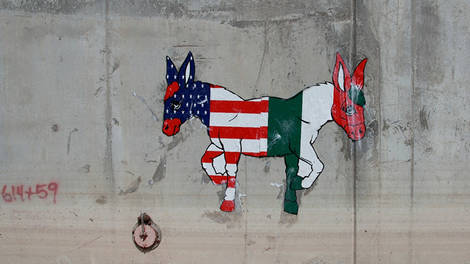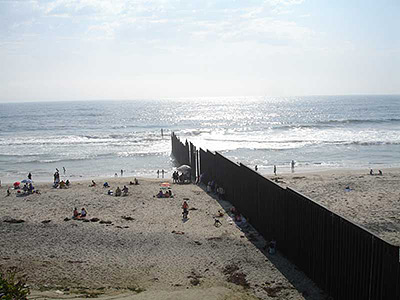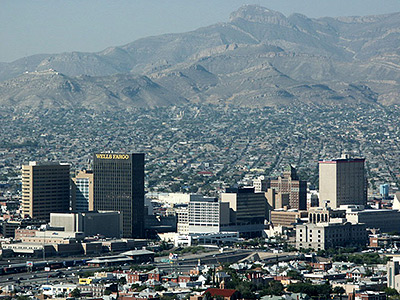
Who’s Red, Who’s Blue?

This is a tale of two cities — two border cities — and the states that they call home. San Diego, California and El Paso, Texas both share an identity as ports of entry on the increasingly controversial international US-Mexico border. But, politically and demographically, this may be one of the only things they have in common. In the evolving red state-blue state political landscape of America, these cities don’t quite fall into line. They act as bright points of color in a shifting political landscape that otherwise appears monochromatic. The identity of these cities within the identity of their states speak to the changing face of the United States and the changing values of new immigrants. Both cities are defying the expectations of political pundits. In El Paso, young Hillary supporters are thronging to Clinton rallies in a predominantly red Texas State. In San Diego, GOP frontrunners like Donald Trump and Ted Cruz are exciting conservative voters in an otherwise blue California state. San Diego and El Paso represent the polarization of American politics and the role that Latinos, immigration and the border will play in our future. As 2016 elections loom, Latino’s are now the biggest minority group and the big swing vote that may decide America’s next president.
Nationally
There has been a massive influx of Latino and Hispanic Americans over the last 30 years. In 1980, with a population of 14.8 million, Hispanics made up just 6.5% of the total U.S. population. According to Census data, as of 2013 there were 54 million Hispanics in the United States, comprising 17.1% of the total U.S. population.
Latinos are historically Democratic voters. In 2006, 69% of Latino voters supported Democratic candidates in congressional races, while 30% supported Republican candidates. In 2008, 67% of Hispanics voted for Democratic presidential candidate Barack Obama, while 31% of Hispanics voted for Republican presidential candidate John McCain. In the 2010 midterm elections, 60% of Hispanics voted Democratic, while 38% voted Republican. Latinos voted for President Barack Obama over Republican Mitt Romney by 71% to 27% in 2012. These number indicate that the growing percentage of Latino voters are also liberal voters. Undoubtedly, Latino voters are going to play a major role in the the 2016 election and candidates are in the midst of fighting for their support.
San Diego
 San Diego, the southernmost county of California, holds the busiest international border crossing in the world, yet it chooses to highlight its heavy Latino influence selectively and rarely. California, well-known as a blue state, has cast a Democratic vote for president in the past six presidential elections(270towin). But San Diego has remained less constant; it has voted Democratically in only three of the last six elections, and Republican for the remaining three. California’s shifting population is changing the outcomes of these elections though.
San Diego, the southernmost county of California, holds the busiest international border crossing in the world, yet it chooses to highlight its heavy Latino influence selectively and rarely. California, well-known as a blue state, has cast a Democratic vote for president in the past six presidential elections(270towin). But San Diego has remained less constant; it has voted Democratically in only three of the last six elections, and Republican for the remaining three. California’s shifting population is changing the outcomes of these elections though.
In the Golden State, Latinos represent about 38% of the state’s adult population, and 27% of the total population is foreign born. In San Diego, about 76% of all immigrants have arrived since 1980, with 24% arriving in the last decade. San Diego’s immigrant population is largely comprised of Mexican immigrants (47%), a group that has grown in the past two decades. (dornsife) According to Census data, 33% of the city’s population now identifies as Hispanic or Latino, and the foreign born population is 23% of residents. This rapid demographic transition is changing the city’s political geography, whether it likes it or not. The influx of Latino voters will force the city to lean left.
El Paso
El Paso is another case study in contrast--nestled against the U.S. Mexico border, the dry desert air carries sounds and scents, rich with Mexican culture. Ciudad Juarez threateningly thrives on the other side of the fence while El Paso remains one the safest cities in the country.
 There’s a clear discrepancy between El Paso’s political geography and Texas’s voting history. The Lone Star State has cast a Republican vote in the last nine presidential elections. Today, 37% of Texas’s population identifies as Hispanic or Latino, and 16% are foreign born.
There’s a clear discrepancy between El Paso’s political geography and Texas’s voting history. The Lone Star State has cast a Republican vote in the last nine presidential elections. Today, 37% of Texas’s population identifies as Hispanic or Latino, and 16% are foreign born.
This is not the case in El Paso, whose more liberal residents voted for a Democratic candidate -- Barack Obama -- for the last eight years. 81% of El Paso’s population identifies as Hispanic or Latino, and 26% are foreign born. El Paso is a blue dot in Bush country.
Border Cities and Latino Voter Power
These cities do not match their states or each other. The more conservative San Diego is nestled on the edge a of true-blue state and often attempts to ignore its function as a “border city.” It has a comparatively lower percentage of Latinos than the state of California as a whole and it's not representative of its democratic home. San Diego is trailing behind the Latino, liberal identity of its state. El Paso doesn't quite fit the image of conservative, Bush-territory Texas either. It is unfalteringly democratic and its Latino population is more than double the statewide percentage. El Paso resonates with its “border city” identity but it remains a stubborn blue patch in a notoriously conservative state. But this is changing, it may also herald a trend-from red to blue. Major cities in Texas are beginning to lean liberal and, looking ahead, the political identity of the Lone Star State is transforming. The only thing shared between these two cities’ “border city“ identity is a separation, both politically and demographically, from their home states.
What both states do have in common is a high percentage of Latinos. Latinos will be the largest voting minority in the 2016 election, and one report suggests that to win the White House, the Republican candidate will need 47% of the Latino vote.
The identity of these border cities within the identity of their states speak to the changing face of the United States and the changing values of new immigrants. Latinos will be a deciding voice in the 2016 election, and the differing attitudes of these two cities reflects the polarization and transformation of present-day politics. El Paso and San Diego and their “border city” identities are different, both from each other and from their states.while San Diego is clinging to its conservative values in liberal territory, El Paso’s contrast in Texas is heralding a period of political transition.
Texas’s March 1st Presidential primary illustrated this contrast. The victors were Republican Ted Cruz, and Democrat Hillary Clinton, with nearly 3 million Republican voters and 1.5 million Democratic voters participating overall. El Paso’s results matched Texas’s, but the voting numbers were a different story. Only 26,825 Republicans cast their vote, while nearly double (53,243) El Paso Democrats participated in the primary election. This means that El Paso’s primary votes matched Texas’s, but there were far more democratic voters than republicans in El Paso. El Paso’s vote matches its state, but the voting numbers reflect the increasingly liberal political participation. California’s June 7th primary will be telling: will San Diego fall in line with its state’s liberal values or continue to be a stubborn hold out?
This election will be strikingly transformative for the United States. San Diego is a red city in a blue state, and El Paso is a blue city in a red state. Their common denominator is their rapidly growing Latino and liberal population. The polarization of theses cities is indicative of the options for our collective future. Will we cling to our pre-conceived notion of our identity, stubbornly denying the changing demographic of our population? Or will we embrace the changing face of the United States and the values that accompany it?
